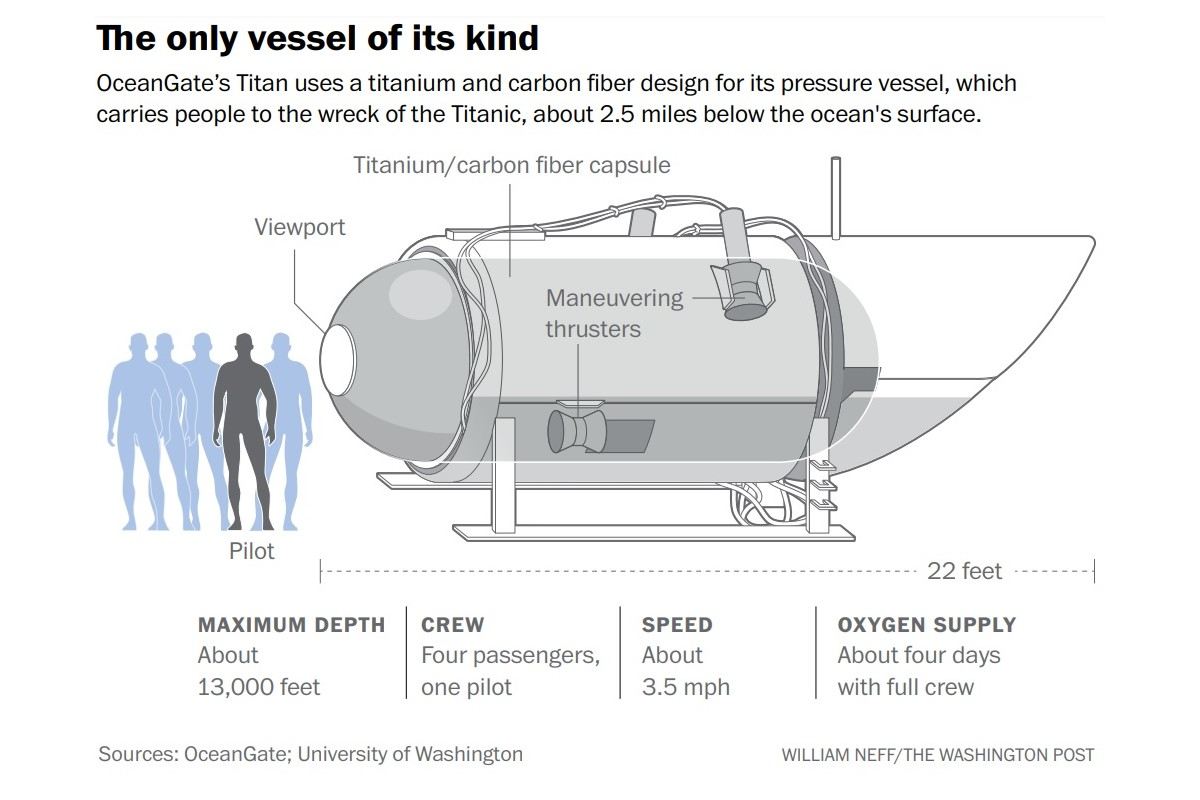
12:17 JST, June 22, 2023
The search for five people aboard the missing submersible that was exploring the Titanic wreck grew Wednesday to double the size of Connecticut and 2.5 miles deep, as noises picked up by sonar have yielded no leads and the vessel’s 96-hour oxygen supply is estimated to run out Thursday.
But the international search effort remains full of “hope and optimism,” said Capt. Jamie Frederick of the U.S. Coast Guard, adding that officials are still planning to recover a live crew.
“This is a search and rescue mission, one hundred percent,” Frederick said Wednesday afternoon. “We’re right in the middle of a search and rescue case, so I don’t want to get into a discussion about when that would end.”
Several Canadian P-3 aircraft detected underwater noises in the area where crews are looking for the Titan submersible, and operations were redirected there, the U.S. Coast Guard’s First District reported early Wednesday. Those efforts “have yielded negative results but continue,” the Coast Guard tweeted.
Carl Hartsfield, a senior manager at the Woods Hole Oceanographic Institution, said at a news conference that officials were conducting an acoustic analysis of what was “described as banging noises.” The sounds could have originated from other constructed sources or animals.
“We don’t know what they [the noises] are, to be frank with you,” Frederick said.
The search and rescue efforts remain focused on the area where the noises were heard Tuesday and Wednesday.
Meanwhile, questions are being raised about the regulatory and safety standards of OceanGate, the company that operates the vessel. Concerns were raised about the Titan as early as 2018, according to court documents reviewed by The Washington Post.
The allegations came from David Lochridge, former director of marine operations at OceanGate, after he was sued by the company in 2018 for allegedly sharing confidential information. Lochridge claimed that OceanGate refused to pay a manufacturer to build a viewport that would meet the required depth of 4,000 meters, or more than 13,000 feet, according to a countercomplaint.
Lochridge said in court filings that paying passengers would not be aware or informed that “hazardous flammable materials were being used within the submersible.” He also expressed concerns about the quality control and safety of the Titan, and he encouraged OceanGate to use the American Bureau of Shipping to inspect and certify the submersible. Lochridge and OceanGate settled the lawsuit in 2018.
An OceanGate spokesman declined to comment on the lawsuit and allegations. Lochridge also declined to comment when reached through his attorney, Blake Marks-Dias, adding that they are “praying for everyone’s safe return.”
Maximilian Cremer, director of the ocean technology group at the University of Hawaii Marine Center, told The Post that the Titan’s hatch, which is bolted from the outside, does not meet standards.
“We are required by the American Bureau of Shipping, by our regulatory oversight, to have a tower, a structure you can climb out of the command sphere in case of emergency at sea surface,” Cremer said. “Plus we can and are required to open under our own power, human power, to be able to open the main hatch.”
Experts in maritime regulation say OceanGate was operating in a legal gray area.
The American-made Titan, which hadn’t received industry-standard certification, was diving into international waters after launching from a Canadian vessel. So OceanGate’s missions fell outside any one country’s jurisdiction, said Salvatore Mercogliano, a maritime historian with Campbell University.
“They are operating in that lawless sea environment,” Mercogliano said. “There’s literally no requirement out there because there’s no one out there to enforce that.”
The Titan submersible has been unaccounted for since it lost contact with the Canadian research vessel Polar Prince during a dive Sunday morning. Built by OceanGate, the 22-foot-long vessel was being piloted by the company’s chief executive, Stockton Rush, toward the wreckage of the Titanic, which sank in the North Atlantic on April 15, 1912.
Rush became known in the Titanic historical community in recent years because of his business venture, Michael Findlay, former president of the Titanic International Society, told The Post.
“Mr. Rush was relatively a latecomer to the scene, only maybe the last few years, when he decided to mount these expeditions and excursions to the site,” said Findlay, who added that he had met Rush but did not know him personally. “I met him, he was a pleasure to know, and I know he consulted with some of our other trustees here at the society.”
Multiple countries have dispatched ships and equipment to the search area, which is 900 miles east of Cape Cod, Mass., and 400 miles southeast of St. John’s, Newfoundland. The U.S. Coast Guard, U.S. Navy, Canadian coast guard and OceanGate Expeditions have established a unified command, the U.S. Coast Guard said Tuesday. A Canadian vessel with a mobile decompression chamber and medical personnel would also be on-site to assist.
The area is “exceptionally difficult to mobilize large amounts of equipment quickly,” Frederick said. Changing weather, currents and sea conditions mean the area that needs to be searched expands by the hour, Frederick said.
Three more search vessels arrived on-scene Wednesday. The Canadian coast guard ship John Cabot has side-scanning sonar capabilities and is conducting search patterns alongside another Canadian coast guard vessel, Atlantic Merlin, as well as the commercial vessel Skandi Vinland.
In total, five “surface assets” were searching for the Titan on Wednesday afternoon, along with two remotely operated vehicles (ROVs), Frederick said. Officials expect to add five more surface assets in the next two days, and “several” ROVs by Thursday, Frederick said.
The Navy dispatched a system – the Flyaway Deep Ocean Salvage System – designed to haul up objects the size of planes and small vessels from the deep ocean floor, a spokesperson said.
Before it could be used, the hauling system has to be welded to a separate vessel, a process that a Navy official estimated would take roughly 24 hours. It was unclear if the welding process had begun as of Wednesday evening. The official, who spoke on background to brief reporters, added that the Navy’s deepest recovery using the system was 19,075 feet. The official couldn’t recall a time when the Navy used the system to recover a human alive.
In addition to Rush, the other four men aboard the missing submersible are British aviation businessman Hamish Harding, French diver and longtime Titanic explorer Paul-Henri Nargeolet, British Pakistani businessman Shahzada Dawood and his 19-year-old son, Suleman.
Nargeolet has made more than 35 dives to the Titanic site in the past 25 years, said Findlay, of the Titanic Society and a friend of Nargeolet’s.
“There’s nobody better and far more experienced than he. If that’s where you are, that’s the person to be with,” Findlay said. “The oxygen levels are slowly diminishing. We’re just hoping for the best.”
The Coast Guard believes that those aboard the submersible have “some limited rations” of food and water available. The Titan can travel at a speed of 3 knots and can support a crew of five for 96 hours, according to an OceanGate document. Coast Guard officials estimated Monday that the vessel had roughly 96 hours of breathable air available to its occupants after it went missing Sunday afternoon.
The company creates crewed submersible vessels that can reach the ocean floor. OceanGate announced in July 2021 that its Titan submersible first dove 3,800 meters (or about 12,500 feet) to the site of the Titanic wreckage.
Much like the current expedition, the first Titan trip was piloted by OceanGate’s Rush, and Nargeolet was aboard.
“This recent dive in Titan to the Titanic wreck site is one of the most memorable dives I have ever done,” Nargeolet said at the time.
Rush founded OceanGate in 2009 to further deep-sea exploration. Less than 10 percent of the global ocean is mapped using modern sonar, according to the National Ocean Service.
"News Services" POPULAR ARTICLE
-

American Playwright Jeremy O. Harris Arrested in Japan on Alleged Drug Smuggling
-

Japan’s Nikkei Stock Average as JGB Yields, Yen Rise on Rate-Hike Bets
-

Japan’s Nikkei Stock Average Licks Wounds after Selloff Sparked by BOJ Hike Bets (UPDATE 1)
-

Japan’s Nikkei Stock Average Buoyed by Stable Yen; SoftBank’s Slide Caps Gains (UPDATE 1)
-

Japanese Bond Yields Zoom, Stocks Slide as Rate Hike Looms
JN ACCESS RANKING
-

Keidanren Chairman Yoshinobu Tsutsui Visits Kashiwazaki-Kariwa Nuclear Power Plant; Inspects New Emergency Safety System
-

Imports of Rare Earths from China Facing Delays, May Be Caused by Deterioration of Japan-China Relations
-

University of Tokyo Professor Discusses Japanese Economic Security in Interview Ahead of Forum
-

Tokyo Economic Security Forum to Hold Inaugural Meeting Amid Tense Global Environment
-

Japan Pulls out of Vietnam Nuclear Project, Complicating Hanoi’s Power Plans





















